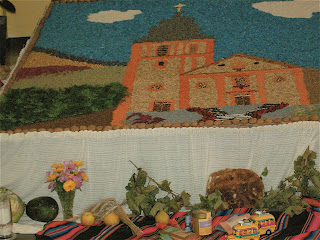 |
| Christmas Market in Stadt Saarburg |
This December I was at a loss for an idea that reflected the Christmas Season in Kreis Saarburg. After eight years of posts about Christmas customs in the Rhineland area of Germany, there wasn't much I hadn't tried to research. Then I found an article that was brief yet concise, full of interesting details I had not known. Thus the information that follows is taken from that source.
In the spirit of the season of the Christmas market, I am including photos from markets which are near to Kreis Saarburg, even though one market is in Strasbourg, France. After all, a Prussian general once referred to our ancestors as "painted French." And at the time the Christmas markets developed, German and French citizenship could change from week to week.
The History of the Christmas Market
The centuries-old tradition of the Christmastime markets were joyful occasions for weary villagers and gave them something to look forward to on the long winter nights. The first Christmas markets were held at a time when regular markets took place throughout the year. The first Christmas markets were little more than winter markets that lasted a couple of days. Instead of the colorful booths that are a part of Christmas markets in our time, traders in some cities just laid their goods out as best they could, sometimes even in the street.
I found it surprising that as early as the 17th century, gift-buying at Christmas Markets had already become a usual thing. There is something about the Christmas spirit that opens the heart and also, at times, the purse.
The usual place for the Christmas Market to be found was surrounding a city's church. In larger cities, the main church was chosen in order to attract the most buyers when residents arrived for the services. According to the writer of the article I am using as a basis for my post, a priest in Nürnberg in 1616 complained that he did not hold the afternoon service on Christmas Eve because no one attended. They were waylaid by the Christmas market.
The same article says, "It is likely that the Christmas markets drew more visitors when religious reformer Martin Luther instituted new customs for Christmas. Before Luther, the exchanging of presents took place on the saint days of St. Nicholas, December 6, or of St. Martin, on November 11. It was Luther who suggested that children receive presents from “the Christ Child,” hence the name “Christkindlsmarkt” (Market of the Christ Child), a popular name for many Christmas markets especially in the south of Germany."
In the past, only local tradesmen were allowed to sell their wares at the city’s market, which led to the distinctive regional character of today’s markets. Because in the past each region had its own customs and needs, Christmas markets have continued to focus their wares in that direction, giving each market a distinctive air. They specialize in "local delicacies and traditional products."
Beyond the commercial aspect of the markets, they have another function: a cheerful, high-spirited place for local residents to meet as well as a place to sell their homemade crafts, decorations, and ornaments.
The items in the Christmas market in each city are not all unique, or course. There are traditional German handicrafts that can be found at nearly every Christmas market. There have to be nutcrackers, wooden figurines, straw stars and smokers as well as the iconic cookie tins, glass balls, toys, and tin tree ornaments.
Since most of us will not have a chance to tour these Christmas markets, here are some photos taken at regional Christmas markets by the photographers listed below:
 |
| Christskindl Market in Stadt Saarburg |
 |
| At the Saarbrucken Christmas Market |
'
 |
| Saarbrucken Market |
 |
| Strasbourg's Famous Christmas Market |
 |
| Strasbourg Market at night |
 |
| Market is next to Strasbourg Cathedral still! |
 |
| Strasbourg Market classic items |
 |
| Delicious Bakery in Strasbourg |
 |
| Trier Christmas Market closeup |
 |
| Trier Christmas Market in the market square |
 |
| The Joy of the Trier Christmas Market |
Merry Christmas Wishes from the Singleminded Offshoot!
Source:
http://www.germany-christmas-market.org.uk/christmas_in_germany.htm
Pictures:
Trier Volksfreund Täglischer Newsletter
Josiane of Lorraine
City of Trier Webpage





,_aged_7,_with_schultu%CC%88te_&_schulranzen,_on_his_first_day_of_school,_Zeulenroda,_1936.wittig-archiv.jpg)











